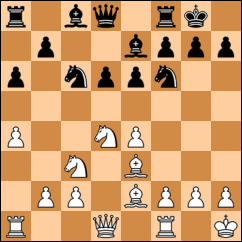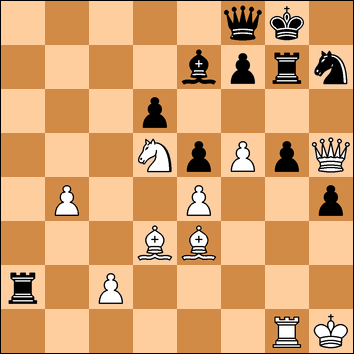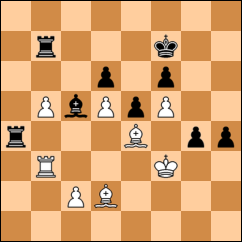FORTUNE FAVORS THE BRAVEYours Truly - Anas Nazreen (2193)
Malay Open (Round 8), 03.02.2003
Sicilian Najdorf
This was my first encounter against Anas in a real competitive game. I had played him once at KYM during the blitz tournament. It was unfortunate that I forgot the game where I completely smashed his king shield before blundering during the time trouble. I could’ve repeated the variation though, if only I can recall it during this game. I always enjoyed pushing my g-pawn up to shatter my opponents’ Scheveningen pawn structure. Kasparov once said that if his opponent wants to win against his Najdorf – Scheveningen set up, they must push the g-pawn. That’s how I destroyed Anas’ King’s fortress then, but this time the push was a little too late.
1.e4 c5 2.Nf3 d6 3.d4 cxd4 4.Nxd4 Nf6 5.Nc3 a6 6.Be2 e6 7.a4 Be7 8.Be3 Nc6 9.0–0 0–0 10.Kh1
After 10.Kh1
This was where I deviated from the above-mentioned game, although this game quickly transposes back to that game continuation three moves later. [refer note on move 13] I timely pushed the g-pawn up, destroyed his King’s shelter, and sent him on the run to seek refuge on the Queenside. However, during the time scramble, and his King already at d7 from his previous position at g8, I blundered away a checkmate. What an anti climax ending to a relatively interesting and pulsating game. Here I give you the variation, even though not to the end because it was a blitz tournament, and I could not remind it correctly.
[10.f4 Nxd4 11.Bxd4 b6 12.Bf3 Bb7 13.g4 h6 14.Be3 Qc7 15.g5 hxg5 16.fxg5 Nd7 17.Kh1 Rad8 18.Bg2 Ne5 19.Qh5 Nc4 20.Bc1+- Me - Anas Nazreen, KYM 2002 Blitz, 18/5/2002 0–1]
10...Qc7 11.f4 b6 12.Bf3 Bb7 13.Qe1
This was where I should push my g-pawn. I couldn’t quite remember why I chickened out during this game and move the Queen instead. I’ve played this position many times before against coach Rizal in training and spectacularly won some of them. Moving the Queen to e1 involves some positional play, whereas 13.g4 is purely a direct attacking play.
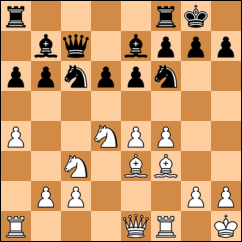
13...Na5 14.Qf2 Nc4 15.Bc1 Rac8 16.b3 Na5 17.Bb2 Nc6 18.Nxc6 Bxc6 19.Rae1
I’ve mistakenly put this Rook on the wrong square. Correct is 19...Rad1 controlling the half opened file: a basic Rook maxim.
19...e5 20.f5 b5 21.axb5 axb5 22.g4
Now this move is a little too late. Black threatens to win a pawn at c2, therefore I must consider giving up the exchange.
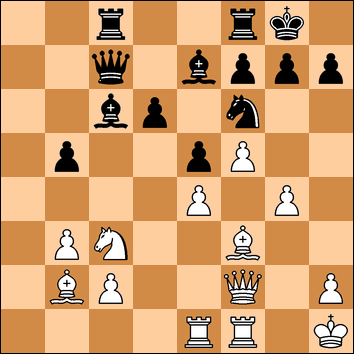
22...b4 23.Nd1 Bb5 24.Ne3 Bxf1 25.Rxf1 h6 26.h4 Nh7 27.Be2 Qd8!
An incredibly good move from a young boy like Anas. Suddenly I found myself giving away pawns after already lost the exchange. Nevertheless, I soundly develop an attacking position against his King using my two Bishop arsenal.
28.g5 hxg5 29.Bd3 gxh4 30.Rg1 Ng5 31.Qg2 Bf6 32.Nd5 Kh8 33.Bc1 Nh7 34.Be3
Threatening 35.Bb6, pushing his Queen away from the defense of the Bishop at f6. Once the Queen moves away, I can safely take the Bishop while threatening mate at g7. Yet, this wonder kid have anticipated the threat and moved…
34...Rb8 35.Bd2 Rg8 36.Bxb4 g5 37.Qg4 Rg7 38.Be1 Ra8 39.Bf2 Ra2 40.b4 Be7 41.Bb6 Qf8 42.Qh5 Kg8 43.Be3
This was the critical position. I should have played 43.Qh6!, threatening to fork the Rook and the Bishop. It was hard to find this simple Queen move during the time pressure. Oh, did I mention that at this very moment, I had 2 minutes to his 10? Analyzing this game afterward, I found that Black is lost in all variations:
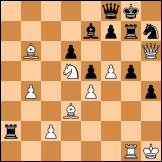
Analysis diagram after 43.Qh6
43...g4 (43...f6 is a mistake. 44.Nxe7+ Qxe7 45.Bc4+ winning the Rook, while 43...Bd8 44.Bxd8 Qxd8 45.Bc4 Rxc2 46.f6 Rg6 47.Ne7+ also wins the Rook) 44.f6 Bxf6 45.Nxf6+ Nxf6 46.Qxf6 +-
43...Nf6 44.Qh6?
Now this move is a mistake. I should have played 44.Nxe7 Qxe7 45.Bxg5! Nxh5 46.Bxe7 Rxg1 47.Kg1 where position is roughly equal.
44...Nxd5 45.exd5 f6 46.Qh5 Qf7 47.Qxf7+
Keeping the Queens with 47.Qf3 is the best option. However, as my time clocked away, I thought that playing without the Queens was safer.
47...Rxf7 48.b5 Bd8 49.Rb1 Rb7 50.Kg2 Bb6 51.Bd2 Kf7 52.Kf3 Bc5 53.Be4 Ra4 54.Rb3 g4+ 0–1
Final position
 Several years ago, at a time when my eyes can still perceive details, I used to like drawing portraits very much. However, I am not an artist who can draw life portraits from life human models, rather I draw portraits from pictures. Among the portraits I drew were those of artists (most of them female) such as Fauziah Latiff, Haleeda and Gillian Anderson of X-Files. I also drew the portrait of myself and one of my chess teammate during my time at the Matriculation Centre, IIUM.
Several years ago, at a time when my eyes can still perceive details, I used to like drawing portraits very much. However, I am not an artist who can draw life portraits from life human models, rather I draw portraits from pictures. Among the portraits I drew were those of artists (most of them female) such as Fauziah Latiff, Haleeda and Gillian Anderson of X-Files. I also drew the portrait of myself and one of my chess teammate during my time at the Matriculation Centre, IIUM. 







